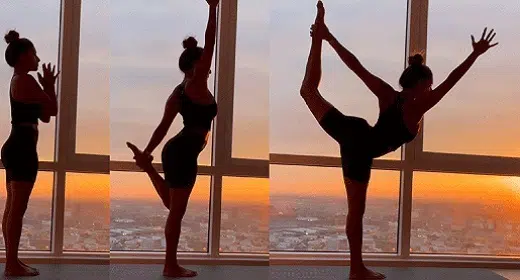by Neeti Narula: Simple and mindful practices. Profound difference…
The concern I hear most from students, aside from not being flexible, is “I’m bad at balancing.” My reaction when I hear this is, “Me, too!”
That’s not what most people expect to hear from their yoga teacher. But it’s true for me. Over the years, though, as I continue to show up to my practice, I’ve realized something that has completely changed my approach to yoga balance poses: Practice doesn’t make perfect. Practice allows you to witness your process.
Balance yoga poses aren’t about the outcome. When you practice asana, you have the exquisite opportunity to notice how you respond to challenges, particularly wobbles and falls. The moments when you lose your balance are the moments that teach you how to regain equilibrium in your body and your mind. Rather than focusing on the outcome of the posture, you instead observe and learn from your process before you try again.
Curiously, the more you learn how to balance on your mat, the more you will be able to take a sense of stability and ease into the world around you.
3 ways to find your balance in yoga poses
The following tools can help you maintain a sense of steadiness in balance yoga poses.
1. Your feet (or hands)
Have you noticed how, when you scrunch your toes or lift the outer edge of your foot in a standing posture, you lose your balance? It’s simple science: The less surface area that is in contact with the ground and supporting the weight of your body, the less stable your balance. When you spread your toes wide and ground down through all parts of your foot that touch the mat, you have more surface area to support yourself.
This principle also applies to arm balances and inversions. You can take up more space with your hands by spreading your fingers wide in intense inversions, such as Handstand, as well as in more common poses such as Adho Mukha Svanasana (Downward-Facing Dog Pose).
Don’t try to completely flatten your foot or hand on the mat. When you pull upward in the natural places that lift, whether the arches of your feet or your palms, you create a suction cup-like seal through your feet. This further supports your balance.
2. Your gaze (drishti)
Have you ever taken note of what your eyes do when you’re anxious? They may dart around and try to settle on something that makes you feel safe and stable.
Your sense of sight is directly connected to your nervous system, so creating a sense of steadiness and ease in your gaze can help your body find comfort in a discomforting situation. Even if you’re struggling with a balancing pose, when you keep a steady gaze, or drishti, you create a sense of stability for both your mind and your body. Let your gaze focus softly on a single point.
3. Your breath
One of the most common things I observe when I cue students into a challenging balance pose is that a lot of them stop breathing. I understand why. When you’re in an unfamiliar or challenging posture, there’s a lot to think about! In addition to the cues your instructor might be sharing, you’re observing, through your peripheral vision, other students falling or wobbling. And then there’s the non-stop chatter of self-talk (including self-doubt) running through your mind.
As challenging as it can be to keep an even breathing pace, it’s essential to maintaining your balance. Because your body must breathe to stay alive, if there is one thing that is going to trigger your nervous system out of its safe zone, it’s holding your breath.
When you are attempting a balance pose, I encourage you to focus more on whether you are actually breathing than whether you can hold the balance. When you steady your breath, you may notice that the balance comes on its own with practice. Allow the process.
Explore your balance and practice along with Neeti Narula in her recorded IG Live sequence for finding balance.










































